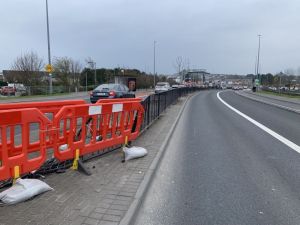The deeply personal reasons behind Catherine Corless’s mission to save single mums

8.11.2020. Catherine Corless holding a candle at the Tuam Mother and Babies site during the Little light of Love walk which saw a lantren carried on foot from Islandeady Co Mayo to Tuam in memory of babies who died at Tuam. Photo Andy Newman
Catherine Corless, Tuam. Photo credit: Andy Newman
Catherine Corless explains why she decided to investigate the Mother and Baby Homes in Tuam.
In 1954, Catherine Corless was born into a different Ireland than the one we live in today.
She would grow up in Tuam, County Galway, alongside a dark grey building surrounded by high walls. This was the infamous Tuam Mother and Baby Home.
Run by the Bon Secours order of nuns, the home took in unmarried, pregnant women; social pariahs of the time.
Today, the grounds bare the shame of what happened in that home; the lack of care given to the women and their newborn babies led to the deaths of 796 babies, and thousands more were illegally adopted out of the home.
Catherine Corless, now in her late sixties, took it upon herself to investigate the horrors of this place and do her best to achieve justice for all the women and babies harmed almost one hundred years later.
In recent years, Catherine has dedicated her time and effort to exposing all of the secrets kept by the home for decades. “There was a terrible stigma against unmarried mothers and their children,” Catherine says.
“Just before they had a start in life, they were condemned already. It was that angle of it that I could see that kept on driving me to get some justice for them.”
More recently, she has consolidated all of her discoveries into a book entitled Belonging: A Memoir, which was released in September of last year.
The home was still active in Catherine’s early youth, only officially closing in 1961.
“I used to walk past it every single day going in and out of school,” Catherine recalls. “I was only passing 10-foot high walls but I was always intrigued, trying to get a peep in at the building”.
Catherine’s interest in investigating local history began with her own mother, who had been born outside of wedlock. “That really started me off on that train.” says Catherine.
“I had to learn where to look and how to look.”
She then took an evening course in Tuam, on local history, which gave her the skills for the work she has done so far.
“More or less, I learned never to give up. If the answer isn’t in one place it may be in another.”
Not one to shy away from hard work, Catherine quickly got access to the deceased babies’ death records; from the Births, Deaths and Marriages office in Galway. In total, she obtained the death records for 796 children who died in the Tuam Mother and Baby home.
Catherine says that she faced many obstacles early on, “I was getting objections from people saying that this was private stuff and not to be interfering”
She remains humble, despite being so well known nowadays. She never intended to become a household name, “I had absolutely no intention of writing a book,” says Catherine. “Or no intention of going on any shows.”
She did so only because she had to; in order to spread the word about the tragic events and not allow it to be covered up any longer, “In the end it became a necessity.”
Catherine has always maintained that several of the deaths of the babies and infants in the home were preventable, despite the lack of healthcare in Ireland at the time, “A lot of them died of things that could have been avoided,”
As previously mentioned, Catherine has written a book on the subject of the homes. Her aim was to find a way to effectively inform people about the homes and what happened there, “The message of the book is for people to stand up and say we’re not standing for this,” says Catherine.
“Anything that happens like that again ever that people will stand up and say this isn’t right.”
Currently, Catherine, and the rest of the country, is waiting for exhumations of the site to begin. There is a possibility that the site will be exhumed this year if the appropriate legislation is passed.
For more Galway Pulse stories, click here.







